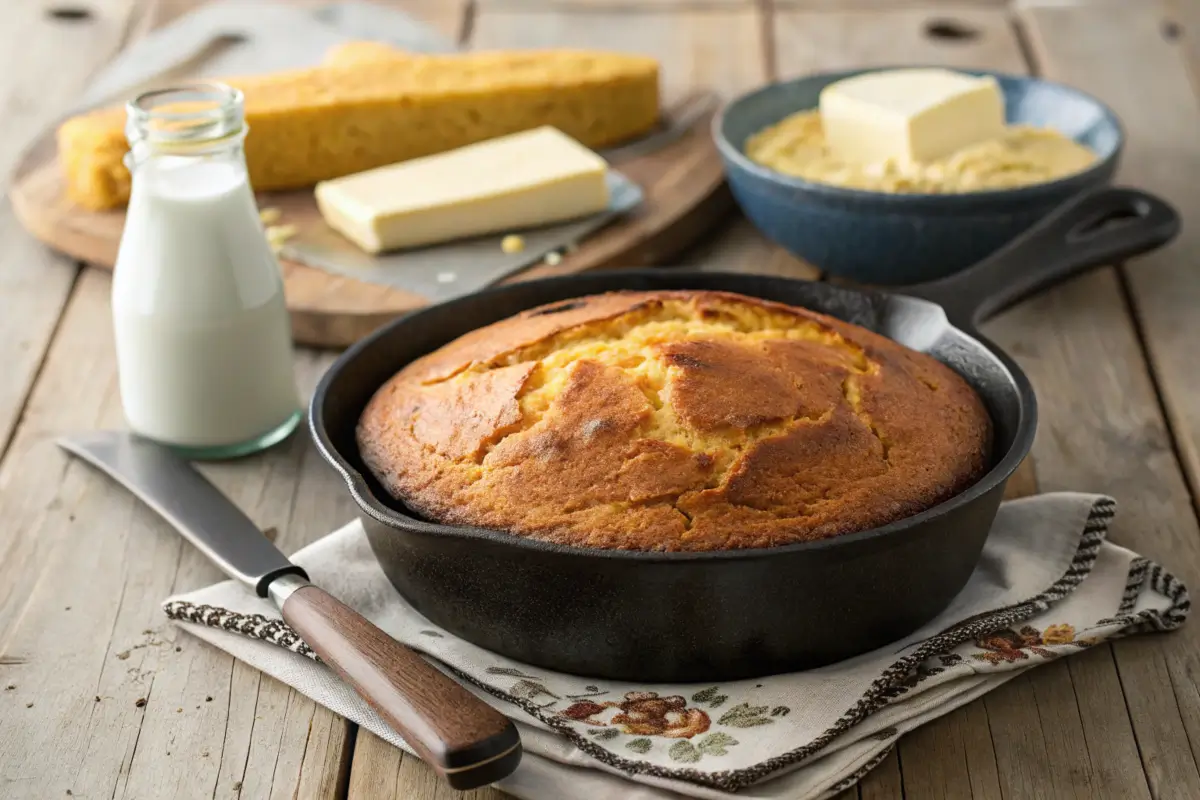Cornbread is a beloved staple in many kitchens, offering a warm, crumbly, and sometimes moist accompaniment to hearty meals. But the debate over whether milk or buttermilk makes for better cornbread is a long-standing one. Each liquid brings its own unique flavor and texture to the table, so understanding their roles can help you decide which is best for your recipe.
In this article, we’ll dive into the history of cornbread, the impact of dairy choices, and the practical considerations that can help you pick the right option. We’ll also cover tips for substitutions, explore expert opinions, and answer some common questions along the way. Let’s start with the basics.
Understanding Cornbread and Its Key Ingredients
The History of Cornbread
Cornbread traces its roots to Native American cuisine, where ground cornmeal was a versatile staple. Over time, the dish evolved with regional twists, incorporating ingredients like milk and buttermilk to create variations that suited different tastes. Today, cornbread remains a cornerstone of Southern cooking, often featured alongside barbecue, chili, or collard greens.
Role of Dairy in Cornbread Recipes
The choice of liquid in cornbread—whether it’s milk, buttermilk, or even water—plays a pivotal role in determining the flavor, texture, and moisture of the final product. Dairy not only hydrates the cornmeal but also reacts with other ingredients, such as baking soda, to create the fluffiness and rise that people adore in their cornbread.
Why Choosing the Right Liquid Matters
Selecting between milk and buttermilk isn’t just about taste. Buttermilk’s acidity interacts with leavening agents to produce a tangy, moist texture, while milk offers a milder, more neutral flavor. Your choice affects everything from the crumb structure to the overall balance of flavors, making it essential to understand their differences before baking.
Nutritional Comparison of Milk and Buttermilk
Caloric Differences Between Milk and Buttermilk
When considering whether milk or buttermilk is better for your cornbread, understanding their nutritional profiles is essential. Milk, often seen as a staple, provides a consistent source of protein and calcium with fewer calories per cup than buttermilk. On the other hand, buttermilk offers a richer profile, with slightly higher fat content due to its cultured nature, making it ideal for recipes demanding a more luxurious texture. This subtle difference can impact the density and mouthfeel of your cornbread, depending on your goals.
Impact on Nutritional Profile of Cornbread
Adding buttermilk to your cornbread introduces probiotics, which may contribute to gut health. The tangy liquid also enhances the absorption of nutrients from cornmeal, thanks to its acidity. Milk, while less complex in taste, offers a more neutral addition to the recipe. Both options are valuable, but your choice will depend on whether you prioritize flavor or simplicity.
Suitability for Dietary Restrictions
For those with dietary restrictions, milk alternatives such as almond or oat milk can be used, but recreating the tanginess of buttermilk might require adding a tablespoon of vinegar or lemon juice to mimic the acidic component. Buttermilk, while slightly richer, may be less accommodating to lactose-intolerant individuals unless using a lactose-free version.
Flavor Profile and Texture Differences

Milk: Neutral Flavor with Light Texture
Milk contributes a mild, versatile flavor to cornbread, ideal for recipes where the cornmeal’s natural sweetness takes center stage. Its thinner consistency leads to a lighter texture, perfect for those who prefer a fluffy, crumbly slice of bread. This characteristic makes milk a common choice for those who enjoy a subtler taste.
Buttermilk: Tangy Flavor with Rich Texture
In contrast, buttermilk elevates the flavor profile with its tangy, slightly sour notes. This cultured dairy product creates a denser, more moist crumb, which many consider essential for authentic Southern-style cornbread. Additionally, the acidity in buttermilk interacts with baking soda to yield a higher rise, contributing to its iconic soft and rich texture.
Impact of Acidity in Buttermilk on Baking
Buttermilk’s acidity doesn’t just influence taste; it also plays a chemical role in baking. By activating baking soda, it ensures an even rise and a tender crumb. For recipes that emphasize depth and richness, buttermilk is often the star ingredient. This quality also makes it ideal for cornbread recipes with add-ins like jalapeños or cheese, which benefit from its robust flavor base.
Practical Considerations in Choosing Milk or Buttermilk
Availability and Cost of Ingredients
One of the first things to consider when deciding whether to use milk or buttermilk in your cornbread is availability. Milk is a household staple and often more accessible, especially in areas where buttermilk might not be readily stocked. On the other hand, buttermilk, while less common, can add a unique twist to your recipe, making the extra effort to find it worthwhile. Budget-conscious bakers may also lean towards milk, as it tends to be less expensive than specialty dairy products like buttermilk.
Recipe Adaptations and Substitutions
If you’re in the middle of baking and realize you only have one of the two ingredients, don’t fret! Milk can easily stand in for buttermilk when combined with an acidic component like lemon juice or vinegar. Similarly, thinning buttermilk with water can mimic milk’s consistency. The key is to maintain the right balance of liquid and acidity to preserve your cornbread’s structure and flavor.
Preferences Based on Regional and Family Traditions
In Southern households, buttermilk often reigns supreme as a tradition-laden choice for authentic cornbread. Its rich flavor pairs well with savory meals and has become a hallmark of the region’s cuisine. Milk, however, is sometimes preferred in recipes from other parts of the country where a lighter, slightly sweeter cornbread is customary. Your choice might ultimately depend on the traditions you grew up with or the ones you want to create.
Suggestion: For more inspiration, check out our Southern Cornbread Recipe for a traditional approach.
How to Substitute Milk for Buttermilk and Vice Versa

Creating Buttermilk with Milk and Vinegar/Lemon Juice
If you’re asking, Is it better to use milk or buttermilk in cornbread?, you’ll be happy to know you can easily create buttermilk from regular milk. Just add 1 tablespoon of vinegar or lemon juice to a cup of milk and let it sit for 5–10 minutes. This simple trick mimics buttermilk’s tang and acidity, allowing you to enjoy its benefits without a special trip to the store.
Using Milk in Recipes Designed for Buttermilk
Substituting milk for buttermilk requires a few tweaks. Recipes calling for buttermilk often rely on its acidity to react with baking soda or powder. To replicate this effect, add a small amount of acid, such as cream of tartar, to your milk. This ensures your cornbread still rises properly and retains its light texture.
Common Pitfalls to Avoid When Substituting
While substitutions are handy, they can sometimes alter the final outcome. For instance, skipping the acidity in a buttermilk-based recipe might leave your cornbread flat or overly dense. Additionally, using milk instead of buttermilk without adjusting the other ingredients could lead to a less flavorful loaf. Always test your substitutions in smaller batches to find the right balance.
Expert and Home Cook Opinions on the Debate
Survey of Professional Bakers’ Preferences
Professional bakers often weigh in on the question, Is it better to use milk or buttermilk in cornbread?. Many lean towards buttermilk for its ability to create a tender crumb and a slightly tangy depth of flavor. The acidity in buttermilk also improves the rise of the bread, making it a favorite among chefs who prioritize texture and richness in their baked goods. That said, some professionals opt for milk in recipes that call for a sweeter, fluffier cornbread, demonstrating that the “best” choice depends on the desired result.
Insights from Southern-Style Cornbread Enthusiasts
In Southern kitchens, where cornbread holds deep cultural significance, buttermilk is often seen as the gold standard. Its tangy richness complements the savory nature of traditional recipes. Home cooks frequently note that buttermilk enhances the bread’s ability to pair with hearty dishes like collard greens or barbecue. Milk, however, isn’t without its supporters, especially among those who prefer a milder flavor and a more crumbly texture.
Popular Online Poll Results
A quick glance at online forums and polls reveals that the debate is almost evenly split. While buttermilk edges out milk slightly in terms of popularity, the choice often boils down to personal preference. Factors like the availability of ingredients and the specific recipe also play significant roles in determining which liquid home cooks use.
For a closer look at Southern cornbread traditions, check out Southern Cornbread Recipe, which embraces buttermilk as the star ingredient.
FAQs: Frequently Asked Questions
Can You Use Water Instead of Milk or Buttermilk in Cornbread?
Yes, water can be used in a pinch, but it may result in a less flavorful and drier cornbread. Adding a bit of fat, like melted butter or oil, can help compensate for the lack of richness.
What Happens If You Use Buttermilk in a Milk-Based Cornbread Recipe?
Substituting buttermilk for milk in a recipe typically makes the cornbread moister and adds a tangy flavor. However, you may need to adjust the baking soda or powder to account for the acidity.
Does Buttermilk Make Cornbread Fluffier Than Milk?
Yes, buttermilk can make cornbread fluffier because its acidity activates leavening agents, creating more air bubbles during baking. This reaction leads to a softer, lighter texture.
Can You Mix Milk and Buttermilk in the Same Recipe?
Absolutely! Mixing the two can offer the best of both worlds, balancing buttermilk’s tanginess with milk’s mild flavor. Just ensure the overall liquid volume matches the recipe’s requirements.
The Role of Culture and Tradition in Cornbread Recipes
How Regional Cuisine Shapes Preferences
When it comes to the debate, Is it better to use milk or buttermilk in cornbread?, cultural and regional influences often tip the scales. In Southern states, buttermilk is almost synonymous with cornbread, a reflection of deep culinary traditions. Historically, buttermilk was a by-product of butter churning and readily available in Southern households. Its tangy flavor became a hallmark of authentic Southern-style cornbread. On the other hand, in Northern states, milk is often the preferred choice, leading to a sweeter and lighter version of this beloved bread.
The Influence of Family Traditions
Beyond geography, family traditions heavily influence which ingredient is chosen. Recipes passed down through generations often dictate the use of either milk or buttermilk, making it a matter of heritage rather than preference. Many home cooks stick to what they learned from parents or grandparents, adding their own touches but keeping the core ingredient unchanged.
Suggestion: For a recipe steeped in tradition, check out the Southern Cornbread Recipe for insights into the cultural significance of buttermilk-based cornbread.
The Final Verdict: Which Is Better for Your Cornbread?
Matching Ingredients to Desired Outcomes
So, Is it better to use milk or buttermilk in cornbread? The answer depends on what you want from your cornbread. If you prefer a lighter, milder loaf with a neutral flavor, milk is your best bet. It’s versatile and works well in recipes that complement sweeter or milder dishes. Buttermilk, with its rich and tangy profile, is the go-to for those who enjoy a denser, more flavorful cornbread that pairs beautifully with savory dishes.
Flexibility Based on Availability and Personal Taste
The good news is that you don’t have to be locked into one choice. With simple substitutions, you can adapt any recipe to suit what you have on hand or what fits your palate. Experimenting with both milk and buttermilk in different recipes will help you discover which works best for your kitchen.
In the end, the debate over Is it better to use milk or buttermilk in cornbread? boils down to individual taste. Whether you choose milk for its simplicity or buttermilk for its bold flavor, both options can yield delicious results that highlight the versatility of this classic dish.

